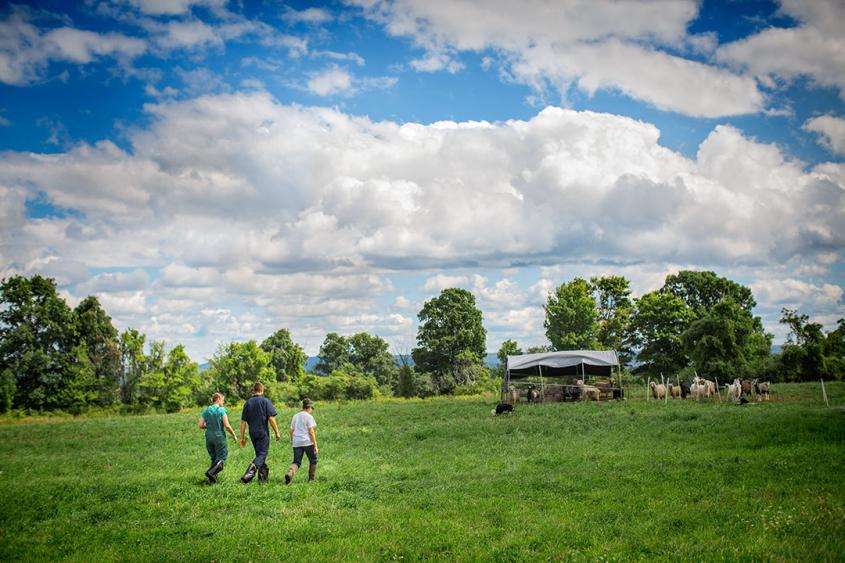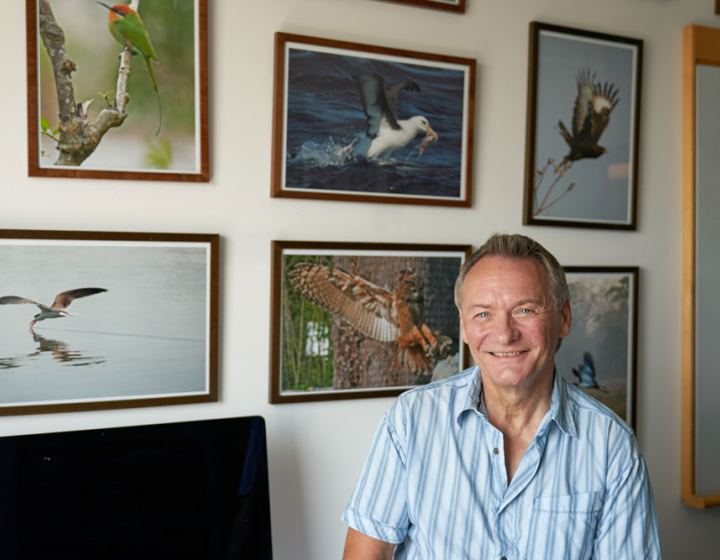Specialty spotlight: Ambulatory and production medicine
It’s a muggy, hot, mid-July morning in Tompkins County, with forecasts threatening highs in the nineties. The ideal clothing for this type of weather is a swimsuit—but Dr. Jessica McArt ’07, assistant professor of Ambulatory and Production Medicine, and DVM students Gabrielle Woo ’17 and Anna Sarfaty ’17, are suited up in full-body canvas coveralls, heavy rubber boots, and plastic chaps—without complaint. This brand of stoicism in the face of discomfort seems to be a prevailing trait within the Ambulatory and Production Medicine Clinic. Whether wading through manure, dodging (and enduring) hard-hooved kicks, or chasing down reluctant patients, these clinicians have been providing expert care to clients for over one hundred years.
First and best
To be more specific, the Cornell University Hospital for Animals (CUHA) Ambulatory and Production Medicine Service has been making calls on clients for 120 years, starting in the year 1896 when Dr. Walter Williams, one of the first six faculty members of the College, developed the ambulatory clinic—the first of its kind in the United States. At that time, Williams was the only practitioner, and owners were responsible for arranging Williams’ transportation to and from the patient.
In 1908, the clinic obtained its own horse and wagon, and eventually an automobile, expanding the service’s reach and the caseload. During the first year of service, the clinic saw 351 cases. By 1930, they were seeing 15,936. The service’s earliest faculty members, Dr. James Frost ’07 and Dr. Denny Udall ’01, were considered the founding fathers of livestock veterinary care, writing foundational textbooks studied by almost every veterinary student of the day. They would later be followed by Dr. Stephen J. Roberts ’38—another author of definitive textbooks—and Dr. Francis H. Fox ’45, the legendary diagnostician—which further bolstered the clinic’s prestigious reputation. “In each era, the ambulatory clinic has been outstanding,” says Dr. Maurice “Pete” White ’75, professor emeritus of Population Medicine and Diagnostic Sciences. “It’s a real jewel in the College’s crown.”
Today the clinic is comprised of five senior clinicians: Charles “Chuck” Guard ’80, Mary Smith ’72, Jessica McArt ’07, Rodrigo Bicalho ’08, and Daryl Nydam ’97; one clinical fellow: Matthias Wieland; and three residents: Vinicius Machado, Antonia Domino, and Franco Leal-Yepes. The team sees the full spectrum of operations—from commercial dairy herds of 8,000 cattle to the hobby farm that has one or two horses. The one constant? White explains: “With ambulatory medicine, you get to be physical, you work with your hands,” says White. “You’re in a rich environment where there’s so much to observe.”
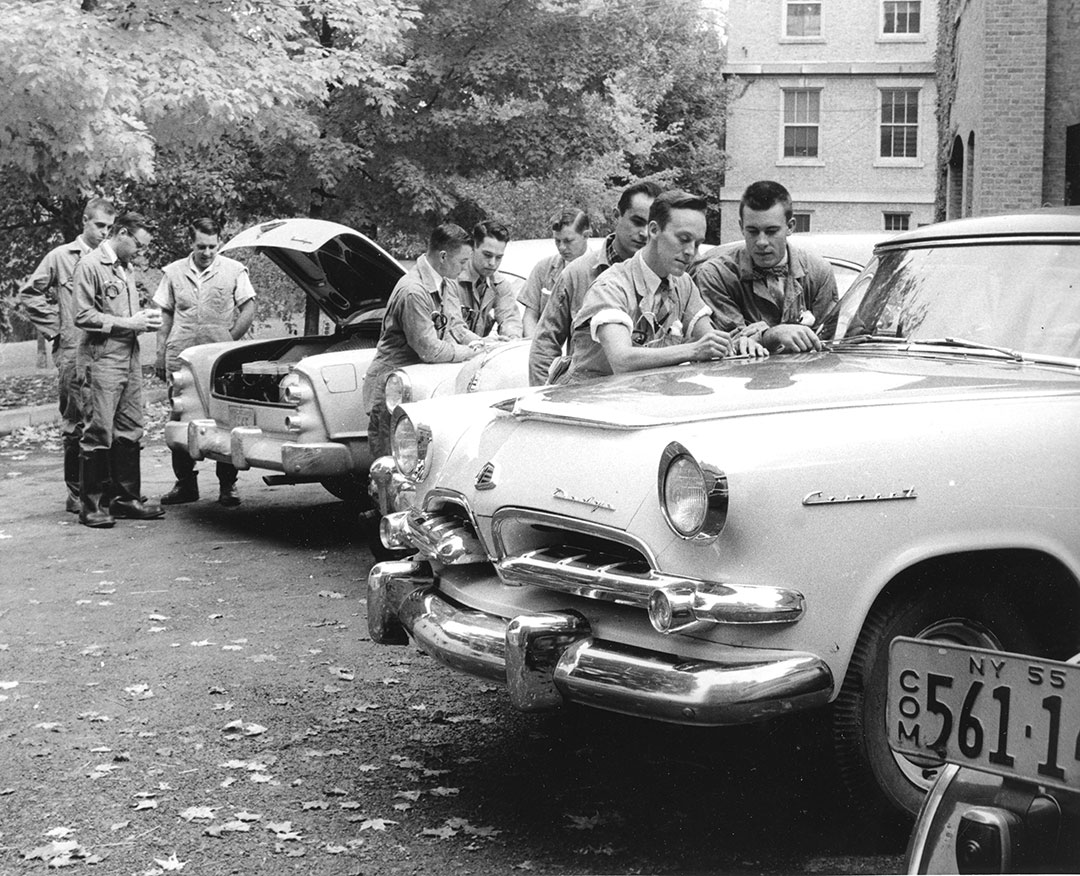
Part of something bigger
On Mondays, the service visits Sunnyside Farm, an outfit in Scipio, N.Y. that milks 3,900 cows every day and is the largest operation seen by the practice. Here, the service veterinarians spend most of their time doing pregnancy checks, but also treat animals for common dairy cow issues such as mastitis, ketosis, and displaced abomasum.
At the main entrance of Sunnyside, an enormous rotary parlor—looking like a futuristic merry-go-round, slowly rotates as it milks 100 cows at a time, with milking machines automatically detaching from the udders once the milk-flow drops to a certain level. With each cow producing roughly four gallons of milk per rotation, this carousel collects a significant amount of milk each time it rotates. Once the cows are milked, they leave the parlor and walk through a metal chute that splits into two paths. An automated gate reads RFID tags embedded in each cow’s ear, sorting each animal so that those that are due for a pregnancy check are separated out from the herd.
This is where the ambulatory service comes in—their task, juxtaposed against all the high-tech equipment, seems shockingly old-fashioned: the vets and students insert their arms shoulder-deep into the rectum of the cow to feel around for signs of a growing embryo.
It’s Gabrielle Woo’s first day on the rotation. “I am not good at this,” the rising fourth-year says as she gropes around inside the obliging bovine. “It takes me forever.” She and the other student on the rotation, Jodi Joseph ’17, are splattered with manure. “How do you manage to stay so clean?” Joseph asks resident Dr. Antonia Domino, whose blue coveralls are relatively unsullied. “First you learn how to do it right, then you learn how to do it quick, and then,” Domino says, “you learn how to do it without getting dirty.”
After these palpations, the cows are marked with fluorescent orange chalk as either pregnant or not (‘open,’ in veterinary lingo). Pregnancy success rates in dairy cows are (like humans’) one-in-three. Open cows are then given a quick injection of prostaglandin or GnRH to synch the animal’s reproductive cycle and get them ready for fertilization once again. This information is entered into the dairy’s digital data management system, which tracks each animal’s fertility cycle and status; milk production over the months and years; milk protein and fat composition; medical history, and where she is at in her fertility cycle.
Cows that are close to calving are taken to a separate wing of the dairy where they give birth in deeply-bedded paddocks. Usually, the process goes just fine on its own, with the Cornell veterinarians only coming in for the rare emergency birth. No emergencies today—just a couple cows quietly laboring, and, in the next paddock over, some very fresh newborns still getting their sea legs under the warm glow of incubator lights.
Despite the commercial setting, the cows appear comfortable and content. Every surface, structure, and process is designed to keep the animals healthy and calm as possible. “I feel pride being connected to the food supply,” says Domino as she looks over the wet and wobbly calves. “We get to make sure things are safe and healthy for our cows, so that they can produce food that’s safe and healthy for us. It’s about being part of something bigger.”
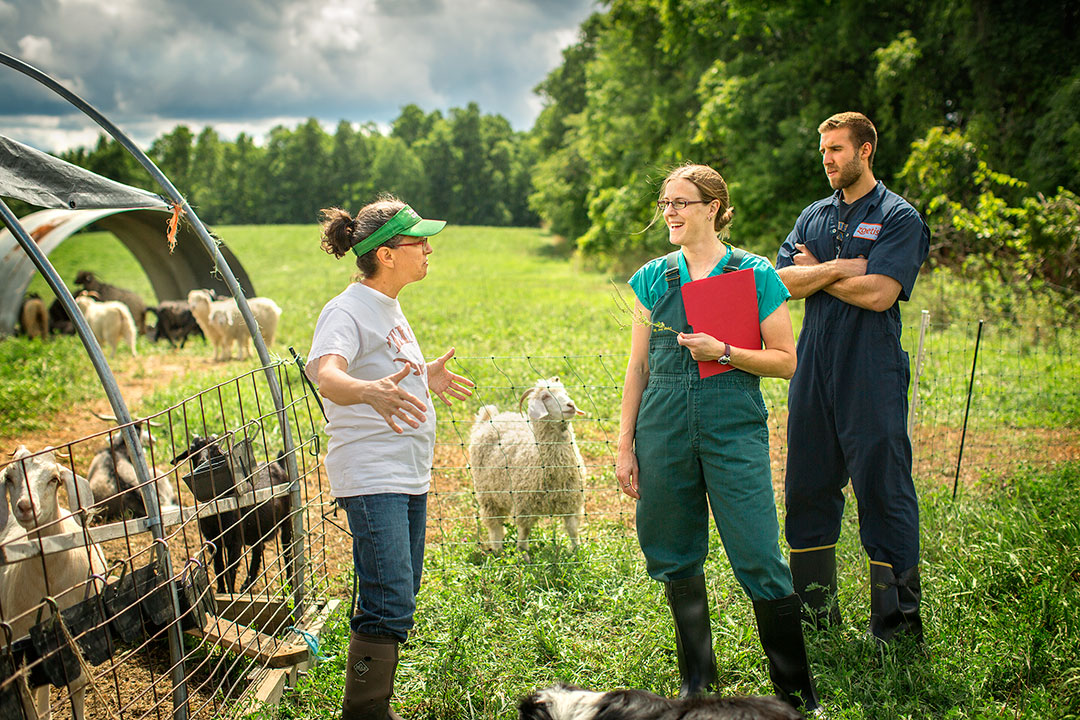
Little farms, lots to do
On the following Wednesday of the week, McArt goes out on the small farm calls, traveling along country roads between Seneca and Cayuga lakes. Today, McArt and the two students on rotation, Woo and Sarfaty, will be doing pregnancy checks for two Amish organic dairies—the same procedure they did at Sunnyside Farm, but on a more modest scale. Here, rather than ear tags with ID numbers, the cows have names, such as “Holly,” “Shirley,” and “Tricky.” The team sets to work palpating the animals—Woo and Sarfaty try first to determine the status of the cow, with McArt following up to double-check. As it is, only a few of these cows are pregnant. The dairy farmer shakes his head; he had bred them to a new, untested bull—one that may not be used again, given his success rate.
Next task is de-horning several new calves, kept in a hay-filled pen. McArt gives the students full responsibility—which means chasing down the nimble animals and pinning them down to first inject them with a local anesthetic and then to cauterize the horn buds.
After another stop at a different Amish farm for more pregnancy checks and de-horning (and a few nerve-wracking close calls with stampeding heifers), the service team piles back into McArt’s red pick-up for their next call—a check-up for a calf that has been sick with a mystery respiratory illness for three months. On the drive over, McArt summarizes the case and quizzes the students. “She clears up once we give her antibiotics and anti-inflammatories, and her appetite remains good, but once she’s done with the treatment, her symptoms come back,” she says. “This is our third course of antibiotics, and the owners don’t want to do any more testing—what else can we do that will fix this calf?” She goes on to stress a key point about ambulatory and production medicine to the students: “Is the test you want to run going to change what you’re going to do with this patient?” Even if they do determine what the primary issue is for the calf, there’s a good chance she’s now too stunted to ‘earn her keep’ as part of a dairy herd—meaning, in the tight-margined world of farming, the calf may need to be culled.
When they get to the calf pens, however, the ‘sickly’ calf is anything but. The fawn-colored youngster is bright and active, and not noticeably smaller than the others. After prying open the animal’s jaws to get a decisive look at her airway, McArt decides no treatment is needed. Even better, the calf seems healthy enough to remain in the herd. The team leaves the farm pleased, but puzzled. These medical mysteries, according to McArt, “are frustratingly frequent.”

Multiple goals
Driving to their next call, McArt discusses how their service differs from a private practice. “We do pride ourselves on operating as close to a private practice as possible,” she says, “but we have a very different goal.” Namely, that of training the next generation of veterinarians. While a private practice veterinarian may get their work done with maximum efficiency, the Cornell Ambulatory Service takes more time; students are learning how to feel the difference between an open and a pregnant uterus, or how to chase down a flighty calf, all under the patient guidance of a seasoned teacher. “That’s my favorite part of this job,” says McArt. “I love being with students who ask questions about stuff —every two weeks I’m with people who find this new and exciting.”
The service has another mission—to facilitate research— and their next stop will do just that. They’ll be visiting Laughing Goat Fiber Farm, a long-time client that raises goats, sheep, and alpacas for wool. The owner, Lisa Ferguson, is letting the team gather blood samples from her animals for baseline data for a new hemocytometer in the clinical pathology service.
The relationship is mutually beneficial in many ways. Besides the routine care for her animals, every November, McArt sits down with her clients for a ‘herd meeting’ to help strategize farming goals. For Ferguson, they discussed improving her animals’ nutrition. “I told her that this year, she needed to record her newborn kid data,” says McArt. As a result, they tracked the weight of all the kids born on the farm, and found that the lactating does needed higher quality hay to produce more milk.
At the Laughing Goat Fiber Farm, McArt meets up with resident Dr. Vinicius Machado and his student, Elizabeth Koelmel ’17—all hands are on deck to collect the blood samples. The alpacas are relatively easy—despite a chorus of nervous humming sounds, the animals allow themselves to be cornered and pricked without much complaint.
Most of the Angora goats are similarly accommodating—the dozen or so animals are in a small paddock and despite the thick, wooly coats and long, twisting horns, the ambulatory team is efficient—until the final three goats. These last few are kept in a large pen in a separate meadow to encourage breeding between a buck two cashmere does, and said buck—an appropriately-named Fred Astaire—and another light-footed doe, prove impossible to catch in spite of the athletic attempts of Machado, Woo, and others to corner them.
Despite running in waist-high grass in full-body coveralls in July, everyone is smiling as they walk back to the trucks—overall, the day has been a success. After chugging down ice-cold water from the client and waving goodbye, the clinicians and students pack back into the pick-up trucks to get back on the road, just as their predecessors piled back in their horse-drawn buggy a hundred years ago. There’s little doubt that Cornell clinicians will be weathering the same mishaps, mischief, and muck with the same brand of resilience a hundred years from now.
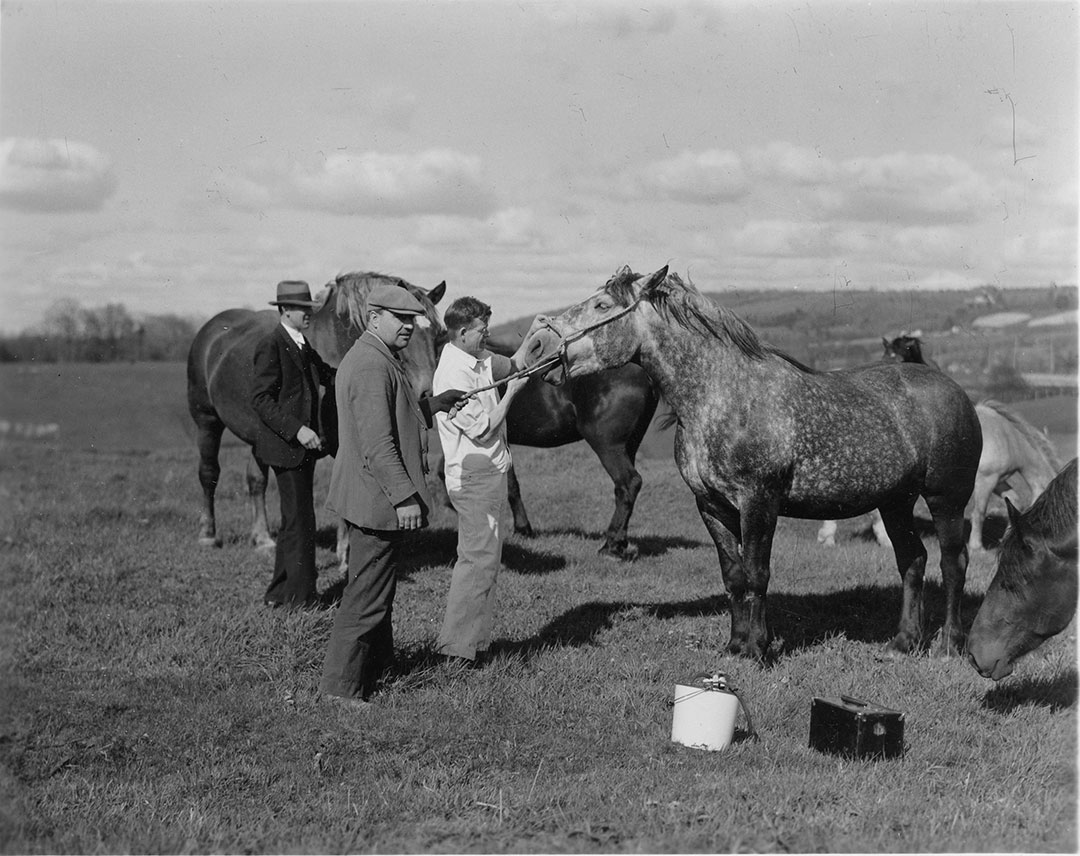
By Lauren Cahoon Roberts



